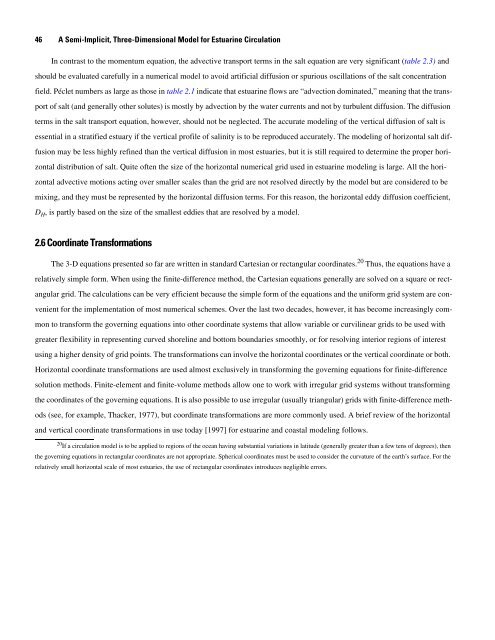A Semi-Implicit, Three-Dimensional Model for Estuarine ... - USGS
A Semi-Implicit, Three-Dimensional Model for Estuarine ... - USGS
A Semi-Implicit, Three-Dimensional Model for Estuarine ... - USGS
Create successful ePaper yourself
Turn your PDF publications into a flip-book with our unique Google optimized e-Paper software.
46 A <strong>Semi</strong>-<strong>Implicit</strong>, <strong>Three</strong>-<strong>Dimensional</strong> <strong>Model</strong> <strong>for</strong> <strong>Estuarine</strong> Circulation<br />
In contrast to the momentum equation, the advective transport terms in the salt equation are very significant (table 2.3) and<br />
should be evaluated carefully in a numerical model to avoid artificial diffusion or spurious oscillations of the salt concentration<br />
field. Péclet numbers as large as those in table 2.1 indicate that estuarine flows are “advection dominated,” meaning that the trans-<br />
port of salt (and generally other solutes) is mostly by advection by the water currents and not by turbulent diffusion. The diffusion<br />
terms in the salt transport equation, however, should not be neglected. The accurate modeling of the vertical diffusion of salt is<br />
essential in a stratified estuary if the vertical profile of salinity is to be reproduced accurately. The modeling of horizontal salt dif-<br />
fusion may be less highly refined than the vertical diffusion in most estuaries, but it is still required to determine the proper hori-<br />
zontal distribution of salt. Quite often the size of the horizontal numerical grid used in estuarine modeling is large. All the hori-<br />
zontal advective motions acting over smaller scales than the grid are not resolved directly by the model but are considered to be<br />
mixing, and they must be represented by the horizontal diffusion terms. For this reason, the horizontal eddy diffusion coefficient,<br />
D H, is partly based on the size of the smallest eddies that are resolved by a model.<br />
2.6 Coordinate Trans<strong>for</strong>mations<br />
The 3-D equations presented so far are written in standard Cartesian or rectangular coordinates. 20 Thus, the equations have a<br />
relatively simple <strong>for</strong>m. When using the finite-difference method, the Cartesian equations generally are solved on a square or rect-<br />
angular grid. The calculations can be very efficient because the simple <strong>for</strong>m of the equations and the uni<strong>for</strong>m grid system are con-<br />
venient <strong>for</strong> the implementation of most numerical schemes. Over the last two decades, however, it has become increasingly com-<br />
mon to trans<strong>for</strong>m the governing equations into other coordinate systems that allow variable or curvilinear grids to be used with<br />
greater flexibility in representing curved shoreline and bottom boundaries smoothly, or <strong>for</strong> resolving interior regions of interest<br />
using a higher density of grid points. The trans<strong>for</strong>mations can involve the horizontal coordinates or the vertical coordinate or both.<br />
Horizontal coordinate trans<strong>for</strong>mations are used almost exclusively in trans<strong>for</strong>ming the governing equations <strong>for</strong> finite-difference<br />
solution methods. Finite-element and finite-volume methods allow one to work with irregular grid systems without trans<strong>for</strong>ming<br />
the coordinates of the governing equations. It is also possible to use irregular (usually triangular) grids with finite-difference meth-<br />
ods (see, <strong>for</strong> example, Thacker, 1977), but coordinate trans<strong>for</strong>mations are more commonly used. A brief review of the horizontal<br />
and vertical coordinate trans<strong>for</strong>mations in use today [1997] <strong>for</strong> estuarine and coastal modeling follows.<br />
20 If a circulation model is to be applied to regions of the ocean having substantial variations in latitude (generally greater than a few tens of degrees), then<br />
the governing equations in rectangular coordinates are not appropriate. Spherical coordinates must be used to consider the curvature of the earth’s surface. For the<br />
relatively small horizontal scale of most estuaries, the use of rectangular coordinates introduces negligible errors.

















